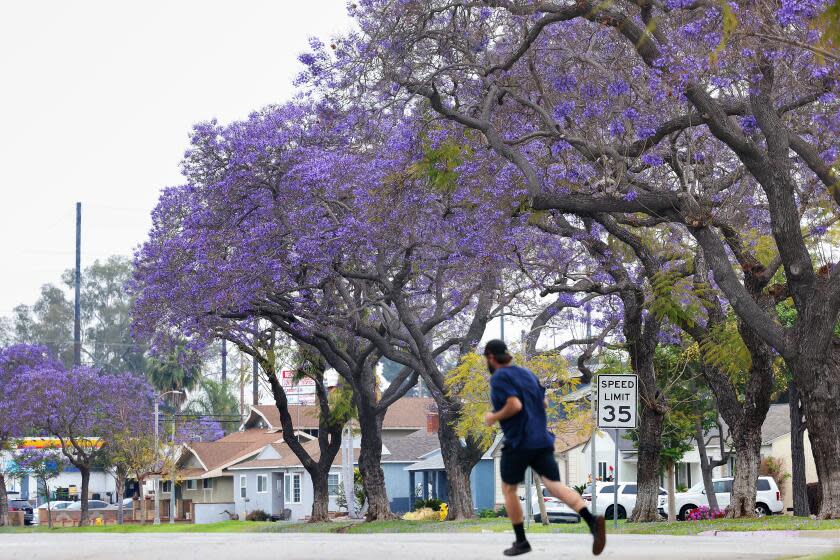Jacarandas are blooming now in L.A., but why are some lagging behind the purple party?

Jacarandas have burst forth once more with their galvanizing purple-blue flowers, an invitation to feel joy or annoyance, depending on one's perspective toward the tree's spectacular yet messy blossoms.
This year's flowering has arrived three weeks earlier than last year's, which many avid jacaranda buffs experienced as later than usual. Gretchen North, a biology professor at Occidental College, says the variable blossoming date reflects the tree's non-native status.
"The thing to realize about tropical trees is that they're not at home here," says North. She explains that jacarandas respond to environmental cues, including heat and light, to determine when to release blossom-triggering flowering time proteins, known as FT. Because environmental cues are different in Los Angeles than in the jacaranda’s native savannas of Argentina and Brazil, the trees do not flower here by clockwork.
Read more: The greatest trees of Los Angeles
Instead, they improvise, leading to jacaranda flower fluctuation on the calendar and block-by-block across Los Angeles. "I live under two jacaranda trees in my house," says Tim Thibault, curator of woody plant materials at the Huntington. "Plants one block away are flowering, but mine, not yet." The San Marino museum has recorded flowering dates as early as Jan. 8 in 2010 and as late as July 7 in 2016. So far, flowering jacarandas have been spotted along residential streets in East Hollywood, Silver Lake, Venice, Pasadena and Long Beach, among other areas.
Thibault pays close attention to the date of the tree's first flowering, and not just because that's when he needs to cover his Jeep to keep off sticky fallen purple flowers. The first day jacarandas bloom is the last day he plants anything until autumn. "Jacarandas bloom because it's warming up and drying out," he says. "Those are conditions I don't want to be trying to establish plants in."
Read more: Column: Why I hate jacarandas
Los Angeles tree maven Stephanie Carrie also marks her botanical calendar with the emergence of the jacaranda bloom. As curator of the online arboretum "Trees of LA," Carrie celebrates the power of jacarandas on Instagram to make Angelenos aware of other remarkable trees that flower simultaneously, such as vibrant orange coral trees.
Carrie notes the international adaptability of jacarandas, which have flourished in traditionally moderate climates from San Diego to Cairo. From Mexico City, however, comes a warning that jacaranda's adaptability is not unlimited. Francisco Arjona, curator of the Instagram account "Trees of Ciudad Mexico," notes that drought and heat this year diminished the jacaranda display he has long admired in Chapultepec Park. He sees their distress amplified in other traditionally hardy urban trees, such as Mexican ash. "Their leaves are not open and looking to the sky," he says . "They're dying very slowly, and it's noticeable in April and May."
Sign up for our L.A. Times Plants newsletter
At the start of each month, get a roundup of upcoming plant-related activities and events in Southern California, along with links to tips and articles you may have missed.
Sign me up.
This story originally appeared in Los Angeles Times.


